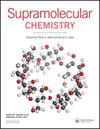Thiophene-benzothiadiazole based donor–acceptor–donor (D-A-D) bolaamphiphiles, self-assembly and photophysical properties
IF 2.6
4区 化学
Q3 CHEMISTRY, MULTIDISCIPLINARY
引用次数: 3
Abstract
ABSTRACT Bolaamphiphilies with D-A-D type π-conjugated rigid cores composed by thiophenes as donors (D) and benzothiadiazole (BTD) as central acceptor (A) have been synthesised. Their self-assemblies and photophysical properties were investigated by polarising optical microscope, differential scanning calorimetry, X-ray diffraction and scanning electron microscopy. Such compounds can self-assemble into honeycomb cylinder mesophases with Colhex∆/p6mm and Colsqu/p4mm lattices in their pure states as well as organogels with different morphologies in organic solvents. Their absorption spectra cover nearly the entire visible light range and their band gaps are relatively low. Tetrathiophene BTD based bolaamphilphiles (BT4/n ) with higher D/A ratios than the bisthiophene BTD bolaamphilphiles (BT2/n ) can self-assemble into more ordered nanostructures in both bulk states and solution. Both the absorption and emission peaks of BT4/n are strongly red shifted. The influence of the molecular conformation, the conjugated core length, as well as the D/A ratio on the self-assemble and photophysical characteristics of such D-A-D bolaamphiphiles are discussed. GRAPHICAL ABSTRACT噻吩-苯并噻唑基给体-受体-给体(D-A-D)亲水分子、自组装和光物理性质
合成了以噻吩为给体(D)、苯并噻唑(BTD)为中心受体(A)组成的D-A-D型π共轭刚性核的亲bolaamphi亲性化合物。利用偏光显微镜、差示扫描量热法、x射线衍射和扫描电镜对其自组装和光物理性质进行了研究。这些化合物可以在纯态下自组装成具有Colhex∆/p6mm和Colhex /p4mm晶格的蜂窝状圆筒中间相,也可以在有机溶剂中自组装成不同形态的有机凝胶。它们的吸收光谱几乎覆盖了整个可见光范围,并且它们的带隙相对较低。基于四噻吩BTD的亲水分子(BT4/n)比基于双噻吩BTD的亲水分子(BT2/n)具有更高的D/A比,可以在体态和溶液中自组装成更有序的纳米结构。BT4/n的吸收峰和发射峰都发生了强烈的红移。讨论了分子构象、共轭核长度和D/A比值对D-A-D亲水分子自组装和光物理特性的影响。图形抽象
本文章由计算机程序翻译,如有差异,请以英文原文为准。
求助全文
约1分钟内获得全文
求助全文
来源期刊

Supramolecular Chemistry
化学-化学综合
CiteScore
3.60
自引率
3.00%
发文量
5
审稿时长
2.7 months
期刊介绍:
Supramolecular Chemistry welcomes manuscripts from the fields and sub-disciplines related to supramolecular chemistry and non-covalent interactions. From host-guest chemistry, self-assembly and systems chemistry, through materials chemistry and biochemical systems, we interpret supramolecular chemistry in the broadest possible sense. Interdisciplinary manuscripts are particularly encouraged. Manuscript types include: high priority communications; full papers; reviews, and; Methods papers, techniques tutorials highlighting procedures and technologies that are important to the field. We aim to publish papers in a timely fashion and as soon as a paper has been accepted and typeset it will be published in electronic form on the Latest articles section of the website. The two most important review criteria are that the paper presents high-quality work that fits generally into the broad spectrum of activities in the supramolecular chemistry field. Under normal circumstances, Supramolecular Chemistry does not consider manuscripts that would be more suitable in a highly specialized journal. This includes, but is not limited to, those based mostly or exclusively on topics such as solid state/X-ray structures, computational chemistry, or electrochemistry. .
The two most important review criteria are that the paper presents high-quality work that fits generally into the broad spectrum of activities in the supramolecular chemistry field.
 求助内容:
求助内容: 应助结果提醒方式:
应助结果提醒方式:


